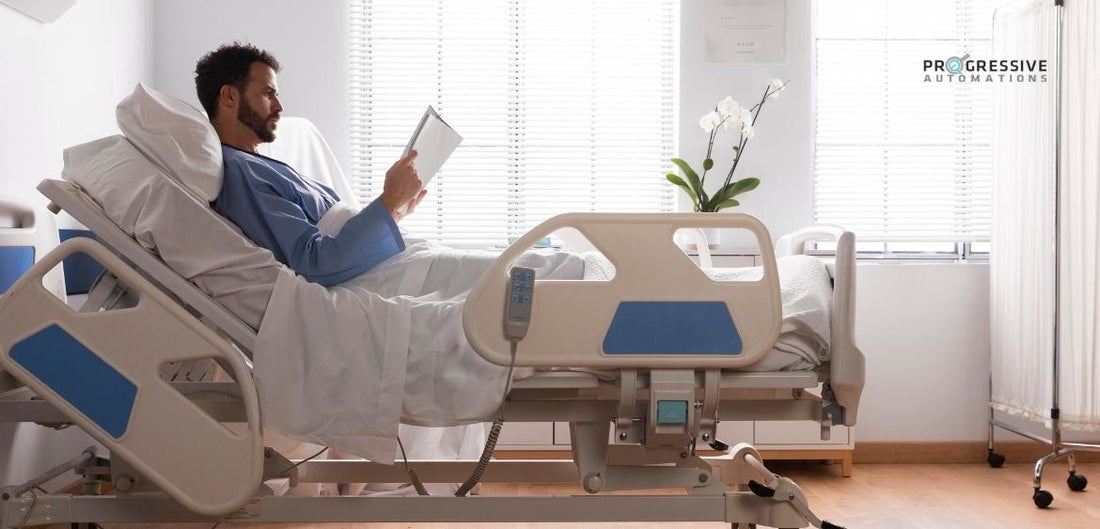The safety of a patient in hospital beds is of the utmost importance, especially for patients experiencing serious health conditions requiring medical treatment. Through the integration of electric actuators and linear motion technology, electrically adjustable medical beds can accommodate different design and specification requirements while offering patients the comfort, safety, and convenience they need. In this article, we will cover how electrically adjustable medical beds have been designed with different components and features that work together to ensure patient safety.
Medical Bed Accessories
Due to such widespread use of medical adjustable beds, accidents are not uncommon and may occasionally result in patient injuries. To help reduce accidents and ensure patient safety, most medical adjustable beds are designed with the following accessories:
- Side rails
- Headboards
- Footboards
- Control Panels/remotes
- Caster wheels

Side Rails
Although side rails offer many benefits to patients and caregivers, they can also cause pressure and entrapment-related injuries when incorrectly used. Patients may also experience a greater fall if they attempt to roll or climb out of the rails. Because of this, each side rail found in hospital beds has sliding or folding capabilities to be placed out of the way when a caregiver has determined that the side rails were no longer needed. Being placed away ensures a safe pathway to enter and exit the bed. The locking capabilities of side rails also ensure safe and reliable means to:
- help prevent the majority of fall injuries
- assist caregivers when repositioning/ turning patients
- provide patients secure handles to hold/grasp on
Headboards and Footboards
Both the headboards and footboards are intended to keep the mattress and patient in hospital beds contained during transportation to another room and while stationary. Unlike the side rails, it is not as crucial to have headboards and footboards that can slide or fold away. Headboards and footboards are typically locked in a fixed vertical position, however, certain models of medical adjustable beds may have horizontal sliding and locking footboards to adjust for the varying heights of different patients.
Control Panels/Remotes

Remotes and control panels are used to configure the heights, positions, safety features, and other various settings of medical adjustable beds. Quick access to the control panels and remotes is crucial for both the patients and caregivers. During different treatments, caregivers may be on different sides of the bed while still requiring access to controls. Certain patients may also require quick access to a handheld remote for changing medical bed positions due to health conditions that happen unexpectedly at random times. Because of these cases, it is common to find a single medical adjustable bed being controlled by multiple control panels and handheld remotes.
Caster Wheels

Caster wheels with locking features are used to keep a medical adjustable bed safely in place as required. Sturdy wheel locks are essential for ensuring safety and confidence while performing treatments and when patients are resting. In cases where a patient needs to be transported to another location, the caster wheels also allow caregivers to move the medical adjustable bed conveniently and efficiently.
Control System Safety Features
To ensure the safety of patients and caregivers, modern-day electrically adjustable medical beds will come with advanced features such as:
- Built-in batteries
- Overheat protection
- Anti-collision protection
- Electronic security locking
- Bed-exit detection
Built-In Batteries

Power outages can happen unexpectedly, however, designs with a built-in dry battery and battery chargers help keep a system prepared to operate at any time. In a low power mode, certain models can still provide an emergency descent function to lower a patient.
Overheat Protection
Certain electronics may have duty cycle requirements to shut off after being operated for a certain amount of time to cool down and prevent burnout. Overheat protection ensures that all electronic devices have the appropriate on and off times for safe operation and greater longevity.
Anti-Collision Protection
Sensors and current draw detection are designed to stop the operation of medical adjustable beds if there were any obstructions that were blocking the bed from changing configurations. This is crucial for ensuring the safety of the patients and caregivers by preventing injuries such as hands and fingers getting crushed between the medical adjustable bed’s lift mechanism.
Electronic Security Locking
If a patient was experiencing mental illness or was unauthorized to change the configurations of a medical adjustable bed, features such as electronic security locking help prevent self-inflicted accidents and injuries. Security locking disables all controls for bed motions by the patient and is designed to only allow access through the passcode or password from an authorized caregiver.
Bed-Exit Detection
Through motion detection and weight monitoring, the bed-exit detection feature can confirm if a patient was attempting to leave the bed. This feature is to help alert caregivers if an unauthorized patient was trying to leave while they were still not fully recovered.
Manual Override Capabilities
In cases of prolonged power outages, the ability to manually adjust medical bed positions for the patient ensures they will still have proper safety when changing bed configurations. Aside from tilting the head and foot adjustments through electric actuators, height adjustable capability also helps make the process of getting in and out of bed much safer for patients experiencing mobility issues. The versatility of linear actuators enables a patient in hospital beds convenient operation in normal conditions while still offering manual operation in cases of power outages from quick release and hand crank features.
Quick Release Electric Actuators

Quick release type actuators in medical beds allow caregivers the ability to raise and lower their patients to the desired position in a short period of time. This style of the electric linear actuator has its pull-style release mechanism which allows for optional manual movement of the shaft in case the patient suddenly needed the bed lowered. In emergencies such as the patient requiring medical assistance or CPR, the quick release offers a faster lowering motion of the bed than normal operation with electrical power. This is also an effective method of lowering patients if there was an electrical power outage.
Hand Crank Features

Hand Crank features are crucial for medical adjustable beds in the event of prolonged power outages. Although they are not as fast at lowering when compared to quick release features, they allow electric actuators the ability to be manually adjusted when changing to a higher height. Certain models of electric actuators may have a manual release hex socket that works similar to a hand crank; however, it requires a hex key to be inserted instead of a hand crank.

In Summary
By integrating the right components and safety features, electrically adjustable medical beds can ensure comfort, safety, and convenience for a large range of patients experiencing different medical conditions. As our technology continues to advance, we can expect to see improvements in the designs, features, and capabilities of electrically adjustable medical beds.
As one of the top suppliers of electric linear actuators, Progressive Automations offers industry-leading flexibility, quality, support, and field experience to meet all your needs. If you have any other questions about what we can offer, please do not hesitate in reaching out to us! We are experts in what we do and want to ensure you find the best solutions for your application.
sales@progressiveautomations.com | 1-800-676-6123




